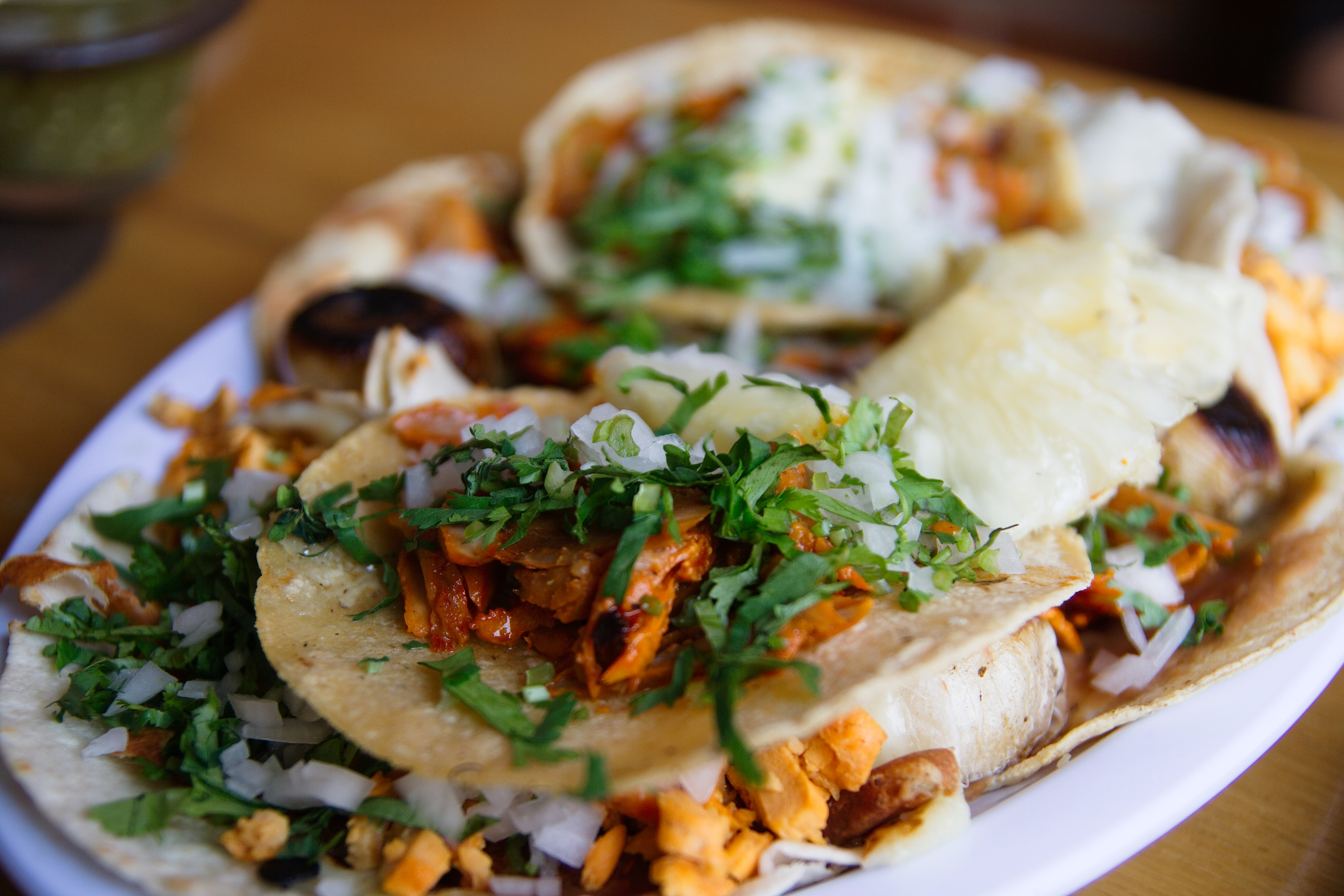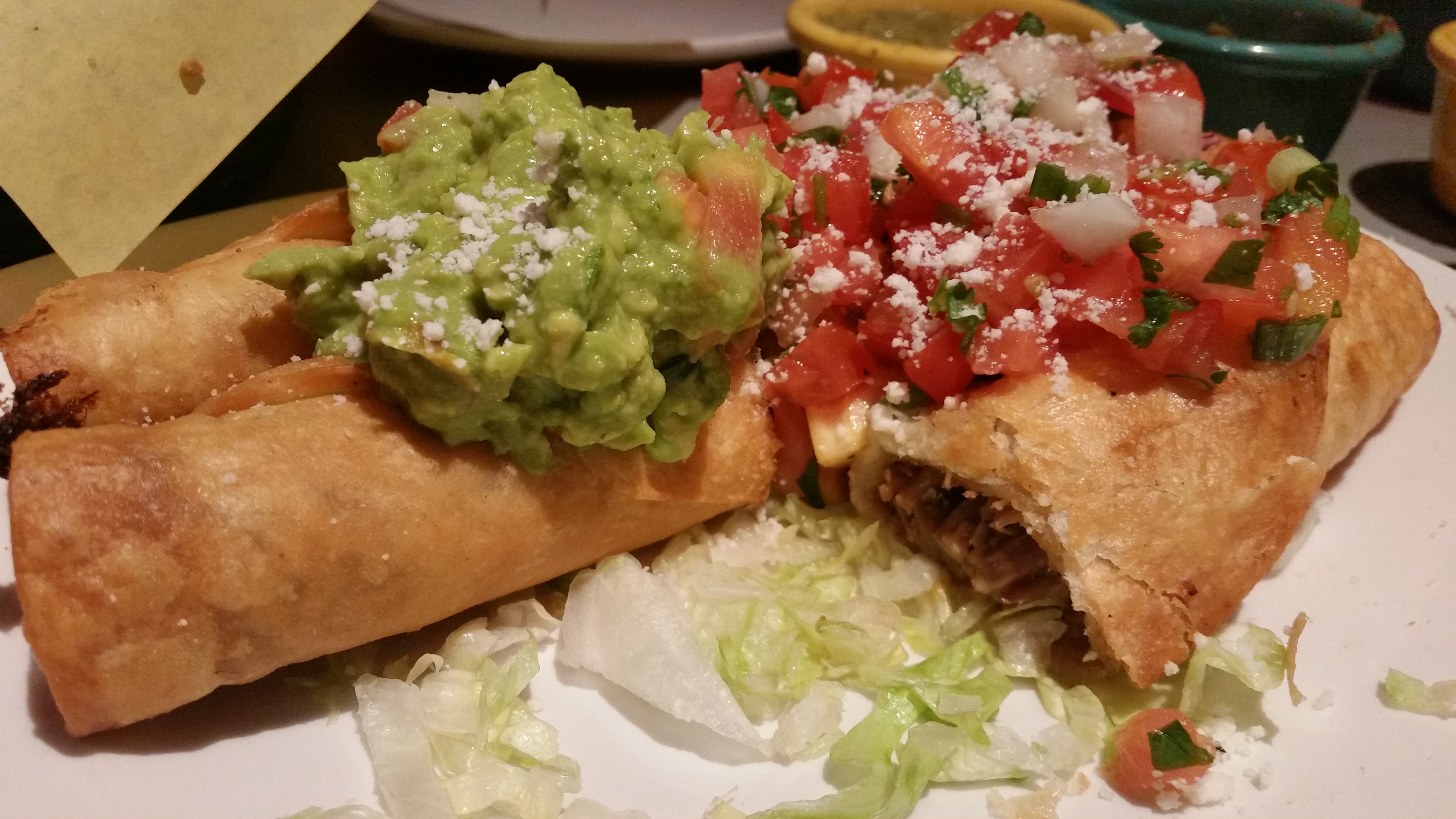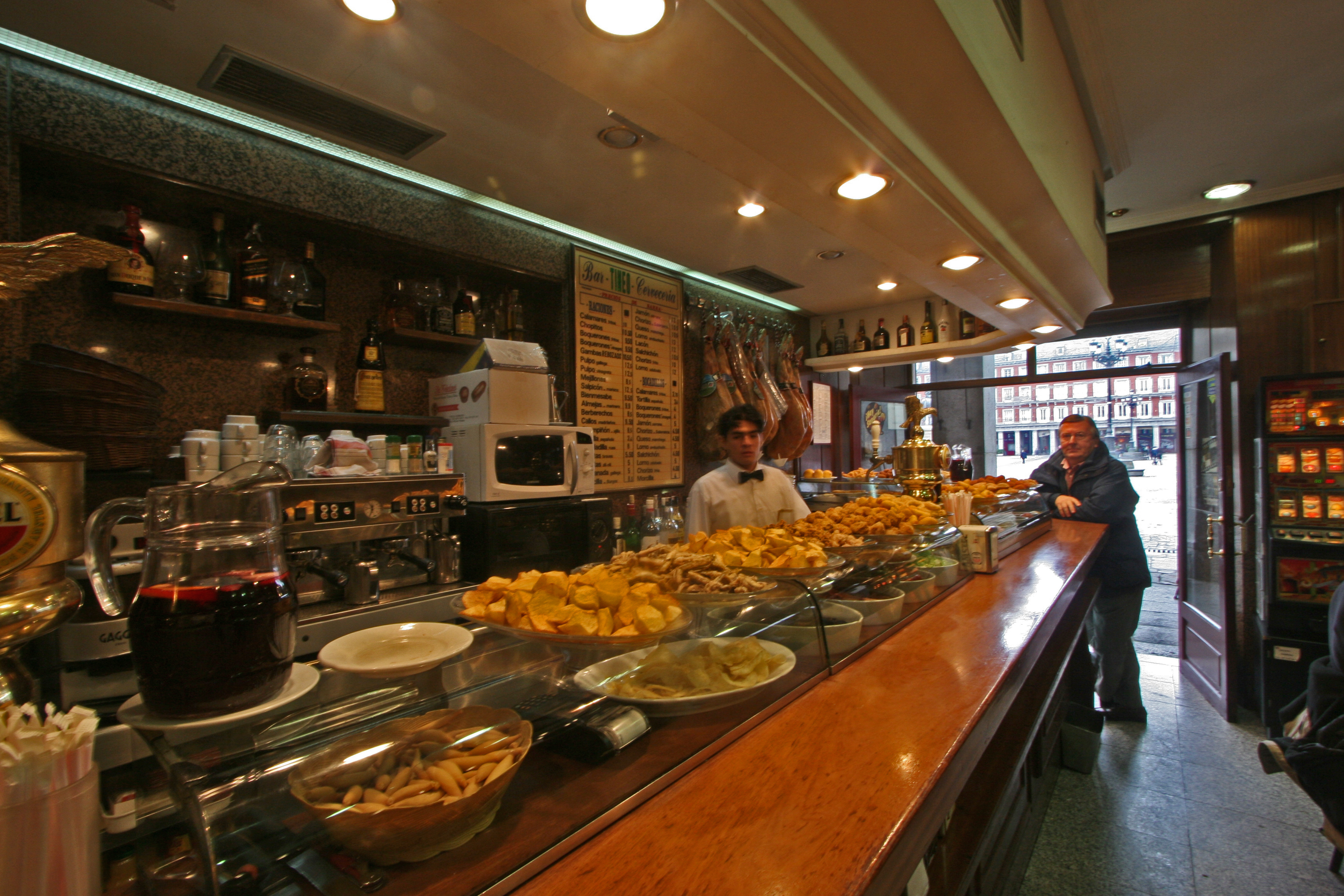|
Taco
A taco (, , ) is a traditional Mexican food consisting of a small hand-sized corn- or wheat-based tortilla topped with a filling. The tortilla is then folded around the filling and eaten by hand. A taco can be made with a variety of fillings, including beef, pork, chicken, seafood, beans, vegetables, and cheese, allowing for great versatility and variety. They are often garnished with various condiments, such as salsa, guacamole, or sour cream, and vegetables, such as lettuce, onion, tomatoes, and chiles. Tacos are a common form of antojitos, or Mexican street food, which have spread around the world. Tacos can be contrasted with similar foods such as burritos, which are often much larger and rolled rather than folded; taquitos, which are rolled and fried; or chalupas/ tostadas, in which the tortilla is fried before filling. Etymology The origins of the taco are not precisely known, and etymologies for the culinary usage of the word are generally theoretical. ''Taco'' in ... [...More Info...] [...Related Items...] OR: [Wikipedia] [Google] [Baidu] |
Mexican Street Food
Mexican street food, called ''antojitos'' (literally "little cravings"), is prepared by street vendors and at small traditional markets in Mexico. Street foods include tacos, tamales, gorditas, quesadillas, empalmes, tostadas, chalupa, elote, tlayudas, cemita, pambazo, empanada, nachos, chilaquiles, fajita and tortas, as well as fresh fruit, vegetables, beverages and soups such as menudo, pozole and pancita. Most are available in the morning and the evening, as mid-afternoon is the time for the main formal meal of the day. Mexico has one of the most extensive street food cultures in Latin America, and ''Forbes'' named Mexico City as one of the foremost cities on the world in which to eat on the street. Definition In Mexican Spanish, the fast foods prepared on the streets and in market stalls are called ''antojitos'' (literally "little cravings") because they are typically foods not eaten at a formal meal, especially not the main meal of the day, ''comida'', which is served in ... [...More Info...] [...Related Items...] OR: [Wikipedia] [Google] [Baidu] |
Taquito
A taquito (, Spanish for "small taco"), tacos dorados,rolled taco, or flauta (, Spanish for "flute") is a Mexican food dish that typically consists of a small rolled-up tortilla that contains filling, including beef, cheese or chicken.Castro, RafaelaChicano folklore: a guide to the folktales, traditions, rituals and religious practices of Mexican Americans. Oxford University Press, 2000. p.217. The filled tortilla is then crisp-fried or deep-fried. The dish is often topped with condiments such as sour cream and guacamole. Corn tortillas are generally used to make taquitos. The dish is more commonly known as flautas when they are larger than their taquito counterparts, and can be made with either flour or corn tortillas. History The taquito or small taco was referred to in the 1917 ''Preliminary Glossary of New Mexico Spanish'', with the word noted as a "Mexicanism" used in New Mexico. The modern definition of a taquito as a rolled-tortilla dish was given in 1929 in a book of st ... [...More Info...] [...Related Items...] OR: [Wikipedia] [Google] [Baidu] |
Al Pastor
(from Spanish, "shepherd style"), is a preparation of spit-grilled slices of pork originating in the Central Mexican region of Puebla, although today it is a common menu item found in throughout Mexico. The method of preparing and cooking is based on the lamb shawarma brought by Lebanese immigrants to the region. features a flavor palate that uses traditional Mexican adobada (marinade). It is a popular street food that has spread to the United States. In some places of northern Mexico and coastal Mexico, such as in Baja California, Mexico, it is known as or . A similar dish also from Puebla that uses a combination of middle eastern spices and indigenous central Mexican ingredients is called . History During the 19th century, variations of a vertically grilled meat dish, now known by several names, started to spread throughout the Ottoman Empire. The Lebanese version, shawarma, was brought to Mexico in the late 19th and early 20th centuries by a wave of Lebanese immigrants ... [...More Info...] [...Related Items...] OR: [Wikipedia] [Google] [Baidu] |
Burrito
A burrito (, ) is a dish in Mexican and Tex-Mex cuisine that took form in Ciudad Juárez, consisting of a flour tortilla wrapped into a sealed cylindrical shape around various ingredients. The tortilla is sometimes lightly grilled or steamed to soften it, make it more pliable, and allow it to adhere to itself. Burritos are often eaten by hand, as their tight wrapping keeps the ingredients together. Burritos can also be served "wet", i.e., covered in a savory and spicy sauce, when they would be eaten with a fork and knife. Burritos are filled with savory ingredients, most often a meat such as beef, chicken, or pork, and often include other ingredients, such as rice, cooked beans (either whole or refried), vegetables, such as lettuce and tomatoes, cheese, and condiments such as salsa, pico de gallo, guacamole, or crema. Burritos are often contrasted with similar dishes, such as tacos, in which a small hand-sized tortilla is folded in half around the ingredients rather than wra ... [...More Info...] [...Related Items...] OR: [Wikipedia] [Google] [Baidu] |
Mexican Cuisine
Mexican cuisine consists of the cooking cuisines and traditions of the modern country of Mexico. Its earliest roots lie in Mesoamerican cuisine. Its ingredients and methods begin with the first agricultural communities such as the Olmec and Maya who domesticated maize, created the standard process of maize nixtamalization, and established their foodways. Successive waves of other Mesoamerican groups brought with them their own cooking methods. These included: the Teotihuacanos, Toltec, Huastec, Zapotec, Mixtec, Otomi, Purépecha, Totonac, Mazatec, Mazahua, and Nahua. With the Mexica formation of the multi-ethnic Triple Alliance (Aztec Empire), culinary foodways became infused (Aztec cuisine). Today's food staples native to the land include corn (maize), turkey, beans, squash, amaranth, chia, avocados, tomatoes, tomatillos, cacao, vanilla, agave, spirulina, sweet potato, cactus, and chili pepper. Its history over the centuries has resulted in regional cuisines based on ... [...More Info...] [...Related Items...] OR: [Wikipedia] [Google] [Baidu] |
Corn Tortilla
In North America, a corn tortilla or just tortilla (, ) is a type of thin, unleavened flatbread, made from hominy, that is the whole kernels of maize treated with alkali to improve their nutrition in a process called nixtamalization. A simple dough made of ground, dried hominy, salt and water is then formed into flat discs and cooked on a very hot surface, generally an iron griddle called a comal. A similar flatbread from South America, called an ''arepa'' (though ''arepas'' are made with ground maize, not hominy, and are typically much thicker than tortillas), predates the arrival of Europeans to America, and was called ''tortilla'' by the Spanish from its resemblance to the traditional Spanish round, unleavened cakes and omelettes (originally made without potatoes, which are native to South America). The Aztecs and other Nahuatl-speakers call tortillas tlaxcalli (''Nahuatl Dictionary.'' (1997). Wired Humanities Project. University of Oregon. Retrieved August 29, 2012, frolink/r ... [...More Info...] [...Related Items...] OR: [Wikipedia] [Google] [Baidu] |
Flour Tortilla
A flour tortilla (, ) or wheat tortilla is a type of soft, thin flatbread made from finely ground wheat flour. It was originally inspired by the corn tortilla of Mexican cuisine, a flatbread of maize which predates the arrival of Europeans to the Americas. Made with a flour- and water-based dough, it is pressed and cooked, similar to corn tortillas. The simplest recipes use only flour, water, fat, and salt, but commercially-made flour tortillas generally contain chemical leavening agents such as baking powder, and other ingredients. History The flour tortilla is a variant of the corn tortilla. The word tortilla comes from Spanish meaning "small cake". The oldest found tortillas date back as far as 10,000 years BCE and were made of native maize with dried kernels. The corn tortilla was the principal food of the Aztecs and other Mesoamerican civilizations. The flour tortilla is a much more recent invention. It is said by some that flour tortillas originated in the northern Me ... [...More Info...] [...Related Items...] OR: [Wikipedia] [Google] [Baidu] |
Chalupa
A chalupa () is a specialty dish of south-central Mexico, including the states of Hidalgo, Puebla, Guerrero, and Oaxaca. Description Chalupas are made by pressing a thin layer of masa dough around the outside of a small mold, in the process creating a concave container resembling the boat of the same name, and then deep frying the result to produce crisp, shallow corn cups. These are filled with various ingredients such as shredded chicken, pork, chopped onion, chipotle pepper, red salsa, and/or green salsa. They can in many cases resemble tostadas since both are made of a fried or baked masa-based dough. Traditional chalupas, as found in Cholula, Puebla, are small, thick, boat-shaped fried masa topped only with salsa, cheese and shredded lettuce. Other regions in Mexico add variations, which can include chorizo, pork, shredded chicken, or re-fried beans, in addition to the classic cheese, salsa, and lettuce toppings. In other instances, the fried masa shape is round, resemb ... [...More Info...] [...Related Items...] OR: [Wikipedia] [Google] [Baidu] |
Maize
Maize ( ; ''Zea mays'' subsp. ''mays'', from es, maíz after tnq, mahiz), also known as corn (North American and Australian English), is a cereal grain first domesticated by indigenous peoples in southern Mexico about 10,000 years ago. The leafy stalk of the plant produces pollen inflorescences (or "tassels") and separate ovuliferous inflorescences called ears that when fertilized yield kernels or seeds, which are fruits. The term ''maize'' is preferred in formal, scientific, and international usage as a common name because it refers specifically to this one grain, unlike ''corn'', which has a complex variety of meanings that vary by context and geographic region. Maize has become a staple food in many parts of the world, with the total production of maize surpassing that of wheat or rice. In addition to being consumed directly by humans (often in the form of masa), maize is also used for corn ethanol, animal feed and other maize products, such as corn starch and ... [...More Info...] [...Related Items...] OR: [Wikipedia] [Google] [Baidu] |
Carne Asada
Carne asada is grilled and sliced beef, usually chuck steak (known as Diezmillo in Spanish), though skirt steak or flank steak can also be used. It is usually marinated then grilled or seared to impart a charred flavor. Carne asada can be served on its own or as an ingredient in other dishes. The term ''carne asada'' translates literally to "grilled meat"; the English-style dish "roast beef" is called by its English name in Spanish, so that each dish has a distinctive name. The term ''carne asada'' is used in Mexico and refers to the style of grilled meat in those countries. In South America, the term used for grilled meat is ''asado'' and it has a different style and preparation. Preparation Carne asada can be purchased from meat markets either prepared (''preparada'', i.e., already marinated) or not (''no preparada''), for marinating at home. The meat is characteristically marinated in lime juice, salt, and Mexican seasonings, but may also be simply rubbed with salt or spice r ... [...More Info...] [...Related Items...] OR: [Wikipedia] [Google] [Baidu] |
Carnitas
Carnitas, literally meaning "little meats", is a dish of Mexican cuisine that originated in the state of Michoacán. Carnitas are made by braising or simmering pork in oil or preferably lard until tender. The process takes three to four hours, and the result is very tender and juicy meat, which is then typically served with chopped cilantro (coriander leaves), diced onion, salsa, guacamole, tortillas, and refried beans (''frijoles refritos''). Description Pork carnitas are traditionally made using the heavily marbled, rich Boston butt or picnic ham cuts of pork. Food Resource Oregon State University. Accessed June 2011. The 6–16 lb (3–7 kg) sections are usually cut down to a workable (6–10 lb) size and [...More Info...] [...Related Items...] OR: [Wikipedia] [Google] [Baidu] |
Tapas
A tapa () is an appetizer or snack in Spanish cuisine. Tapas can be combined to make a full meal, and can be cold (such as mixed olives and cheese) or hot (such as ''chopitos'', which are battered, fried baby squid, or patatas bravas). In some bars and restaurants in Spain and across the globe, tapas have evolved into a very sophisticated cuisine. In some Central American countries, such snacks are known as ''bocas''. In parts of Mexico, similar dishes are called ''botanas''. History The word "tapas" is derived from the Spanish verb ''tapar'', "to cover", a cognate of the English ''top''. In pre-19th-century Spain tapas were served by ''posadas'', ''albergues'' or ''bodegas'', offering meals and rooms for travellers. Since few innkeepers could write and few travellers read, inns offered their guests a sample of the dishes available, on a "tapa" (the word for pot cover in Spanish). According to ''Joy of Cooking'', the original tapas were thin slices of bread or meat wh ... [...More Info...] [...Related Items...] OR: [Wikipedia] [Google] [Baidu] |








